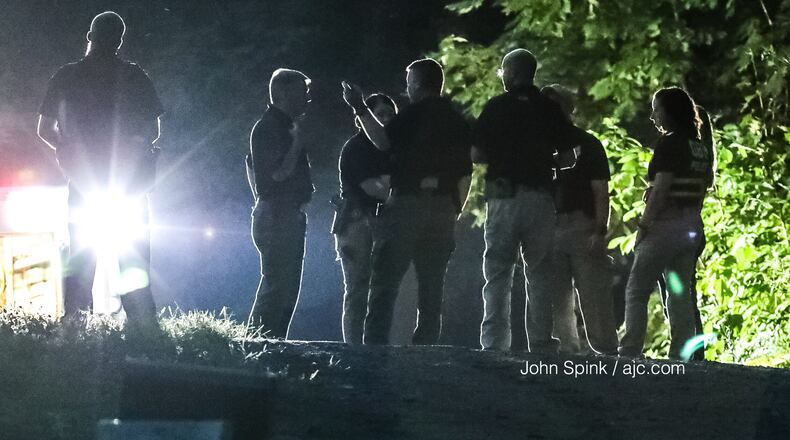Georgia law enforcement officers were involved in 53 fatal shootings in 2018, a large jump from recent years, according to an analysis by The Atlanta Journal-Constitution.
The number, which included four cases where officers died after being shot, was up 77 percent from 2017, when 30 officer-involved shootings involved deaths. It’s unclear what made shootings so much more deadly in 2018, but drug abuse and mental illness are two factors authorities have cited behind some of the deaths.
The increase in deadly encounters happened even as the total number of officer-involved shootings in 2018 — including those where someone died and those where no one did — was 95, down slightly from 97 in 2017.
The total numbers for 2018 include three cases in which officers died after being shot. A fourth officer died after being shot by a suspect, but the case isn’t included because officers didn’t shoot anyone in the incident. Two other Georgia officers died this year after being stuck by vehicles.
Since 2010, the AJC has found, the average number of Georgians killed in officer-involved shootings has been 30 a year. Georgia surpassed 2017's 30 deadly shootings in August, and officials with the Georgia Bureau of Investigation and the Georgia Public Safety Training Center said at the time they were trying to understand the increase. Any such study can be difficult because the investigations into each case generally takes between six months and a year, according to the GBI.
The GBI investigates police shootings in which someone is seriously injured or killed for nearly every agency in the state, including the large departments around metro Atlanta. The GBI also investigates any case in which an officer fires a weapon in the direction of a person but misses, if that officer’s agency requests the investigation. Agencies aren’t required to request assistance in police shootings, but most do, especially since public scrutiny has risen in recent years.
In November, the GBI said one cause behind the increasing numbers of deadly encounters with officers could be drug abuse. In roughly 20 percent of fatal officer-involved shootings since 2012 in the state, the GBI found that those who were shot had methamphetamine in their system. The drug, known to cause erratic and violent behavior, has been surging in Georgia — and across the country — in the past few years as Mexican cartels push more plentiful and potent supplies into America, officials have said.
Frank Rotondo, the executive director of the Georgia Association of Chiefs of Police, said he doesn’t know what factors are behind the increase in deadly shootings. But it does track with increases he’s been hearing about at departments across the country, he said.
“I really can’t tell you why,” Rotondo said Monday. “I think we’re all looking for an answer.”
He wondered whether mental health also plays a role because, along with drugs, mental health issues are another common factor for a number of civilians killed in police shootings.
RELATED:
Henry officer is Georgia’s 6th killed in line of duty this year
Slain DeKalb police officer ‘a person of great promise’
To better train officers to recognize and handle mental illness or drug addiction, in 2016 Gov. Nathan Deal expanded the availability of a 40-hour course on crisis intervention. The goal was for every officer in the state to be trained in how to respond to either situation.
Previously, a single GBI worker oversaw the training program statewide. Now the Georgia Public Safety Training Center has hired more teachers and is running the course in satellite locations across the state, Rotondo said, but some officers have not yet completed the training. A tally of how many officers had completed it wasn’t immediately available Monday. By January 2018, about 20 percent of Georgia police had finished.
Prior to 2015, roughly a quarter of the fatal officer shootings in Georgia involved people who exhibited signs of mental illness, a proportion that matched national figures, a previous AJC report found. From 2015 to 2017, the ratio was about one in three. Numbers for 2018 aren't yet available because details on many of the cases are still under investigation.
A GBI study that was still in progress in December found that, thus far, about 20 percent of the 2018 officer use-of-force incidents the GBI investigated involved a person struggling with mental illness. The incidents considered were shootings, as well as cases in which officers used Tasers and other types of force.
GBI Director Vernon Keenan, who retired Monday, said the study showed room for improvement in officers’ response to mental health crises, though he said the increased training is a strong first step. Also, he said 20 percent was deceptively low, because in many cases, information about the civilian’s mental health wasn’t available.
Digital audience specialist Pete Corson contributed to this article.
Georgia’s officer-involved shootings:
2018 - 53 fatal shootings among 95 total officer-involved shootings
2017 - 30 fatal shootings among 97 total officer-involved shootings
Numbers based on AJC analysis and Georgia Bureau of Investigation data
Officer-involved shootings are under increasing scrutiny as communities seek answers on why officers shoot. Investigating the rising number of officer-involved shootings has become a top priority for the GBI. The AJC tracks these incidents, including reporting when officers are found at fault or when their own lives are taken in fatal exchanges.
About the Author
The Latest
Featured



